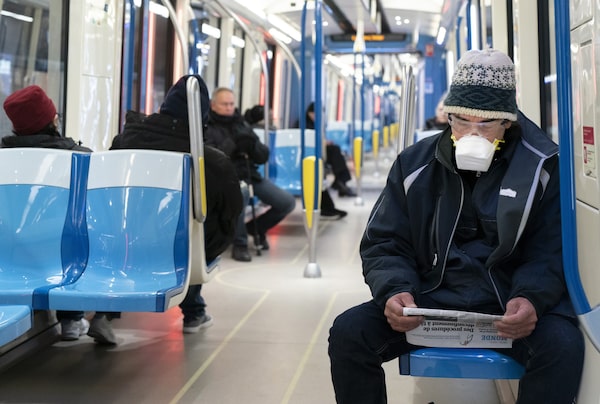
Montreal, April 22: Commuters keep their distance on a nearly empty subway train. At this point, masks were strongly recommended but not mandatory for Quebeckers using public transit, though that would change as the pandemic evolved over the summer.Paul Chiasson/The Canadian Press
In the early days of the pandemic, many people who had to ride transit resorted to desperate measures.
With protective gear in short supply, some wrapped themselves in garbage bags and wore dishwashing gloves. Others carried disinfectant wipes and swabbed every nearby surface. In a picture that went viral, one woman in China was photographed with a plastic bottle over her head.
But millions around the world who could avoid transit did so. And many have stayed away ever since.
Fears about enclosed spaces and crowds, as well as a major shift to working from home and an early, though widely criticized, study about transit safety, helped slash ridership on buses and trains. On some vehicles, there were more fare inspectors than passengers.
“What we’re trying to accomplish is bringing people back,” says Marco D’Angelo, CEO of the Canadian Urban Transit Association, which has scores of member agencies. “For the sake of social inclusion and the environment, we cannot allow an essential service like transit to fail.”
Restoring ridership requires public trust in transit safety. At the same time, the agencies need to sustain the faith of the governments that fund them to keep building expensive infrastructure for a transportation future that changing work patterns have rendered uncertain.
Transit ridership has risen from the depths it plumbed in March and April, but it remains low. The Toronto Transit Commission says it’s at about 35 per cent of normal capacity, while Vancouver’s TransLink is at 43 per cent. London’s subways and buses are carrying about one-third of their pre-pandemic riders. New York’s MTA is around 30 per cent.
Often those who have returned had no other choice. These were the easy riders to bring back; much harder will be luring back those who have more transportation options.
“We’ve got the silent majority who are not using it. That’s the big challenge,” says Alex Williams, director of city planning for Transport for London, which oversees transit operations in the British capital. “Big cities rely on effective mass transit systems. Either a [subway] or a great bus network. And you have to get them back on the network. Because otherwise you go down the route of a gridlocked city, which is in no one’s interest.”
Seoul, Aug. 24: Masked commuters ride a subway train as the South Korean capital's skyline rolls past. Thousands of people use public transit in Seoul every day.Kim Hong-Ji/Reuters
There is hope for a transit recovery – that transmission risks on these vehicles might be lower than initially believed.
Studies in the spring and summer found no coronavirus clusters originating with train use in either Paris or Tokyo (albeit with smaller crowds than normal). Both Seoul and Singapore, where enormous numbers of residents use transit daily, are among the global cities least hit by COVID.
There may be a few reasons for the low transmission rates. Subway and commuter trains replace the air onboard repeatedly – in some cases every few minutes. Many agencies say compliance with masking rules has improved dramatically, rising above 90 per cent in both Toronto and Vancouver. People aren’t generally on board for extended periods, and they certainly aren’t chatting with fellow passengers.
“It’s not an area where people socialize. It’s not an area where people have alcohol,” says TTC chief executive Rick Leary.
“People are typically in public transit commuting by themselves or with somebody who’s in their circle, right? It’s not an engaging environment."
In September, a report commissioned by the American Public Transportation Association concluded that “no direct correlation” had been found between transit use and COVID transmission. Also, “an analysis of public transit ridership in multiple cities shows no correlation with the rise or fall of local COVID-19 cases.”
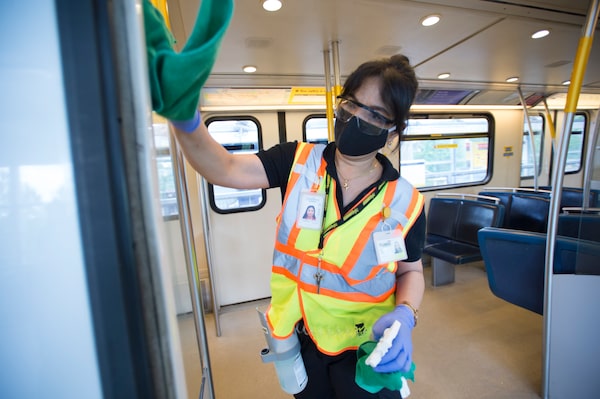
Vancouver, May 21: A cleaner demonstrates how SkyTrains are disinfected.Jonathan Hayward/The Canadian Press
But leaders of some agencies remain reluctant to shout this from the rooftops.
“It’s tricky for me as, say, the CEO to go out and say, ‘Look at these various studies – we’re not seeing any evidence of community transmission. Therefore it’s safe to take public transit,' " says Kevin Desmond, head of Vancouver’s TransLink, noting that the circumstances in each city and agency are different. “Instead, what we hammer on is the safe operating action plan – that we’re doing everything in our power to make the environment safe and then, you know, the choice is yours.”
The theory is that when the risk-reward analysis feels right, people will return. “I think that message will gradually get out there, and in places where public transit is fantastically useful and liberating, people will gradually come because it is the logical thing for them to do,” says Jarrett Walker, a consultant based in Portland, Ore., and author of the book Human Transit.
That could take time, however. A University of Toronto survey published in May found that one-quarter of local transit riders wouldn’t get back on board without a vaccine.
In Vancouver, Mr. Desmond says that TransLink projections for full resumption range from two to as many as eight years. Other agencies – including the TTC – have yet to come up with even loose timelines. Mr. Williams, in London, says his agency is still gaming out various scenarios for long-term COVID effects, ranging from accelerated urbanization to a decline of London itself.
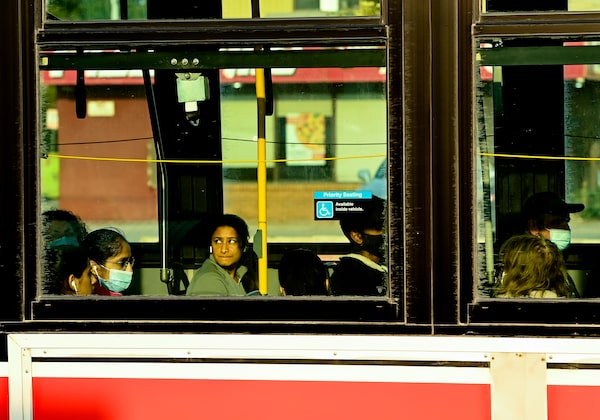
Toronto, Oct. 9: Riders look out from a TTC bus. The city's transit agency has no clear timeframe for when its ridership levels might return to normal.Nathan Denette/The Canadian Press
If overall ridership remains low for the foreseeable future, that could undermine plans for some major transit projects – particularly since it remains unclear whether commuters will ultimately return.
In London, Mr. Williams says there will have to be a clear-eyed assessment of the business case for transit lines now in the planning stages – but he doesn’t believe development should stop.
“The assets we’re building will last hundreds of years,” he says. “I think that’s what we have to avoid – a kind of turn-off-the-tap in the entire pipeline of projects. You need to slow it down and reflect and think about it. But I’m convinced that people will come back.”
He also notes a nuance hidden by top-line reporting on decreases in ridership. Although Transport for London is now at roughly one-third of prepandemic volumes, surveys have shown that two-thirds of residents had used the system in the previous month. So while many people are using transit less, only a minority are shunning it entirely.
One possible effect of the coronavirus pandemic is that fewer people will commute at traditional times – if at all. That’s not necessarily a bad thing for transit agencies, which have traditionally spent enormous sums to meet the peak demand of rush hour. Smoothing out those spikes and spreading service throughout the day could make it easier for transit providers to focus on making the system more useful to more citizens.
A number of agencies are already moving in that direction. Paris is building a massive subway expansion ringing the city so residents trying to access an adjacent suburb don’t necessarily have to travel into the downtown core to catch an outbound train. And Metrolinx, the Toronto-region transit agency whose trains traditionally served office workers – running into downtown in the mornings and out in the evenings – has been shifting to all-day service in both directions.
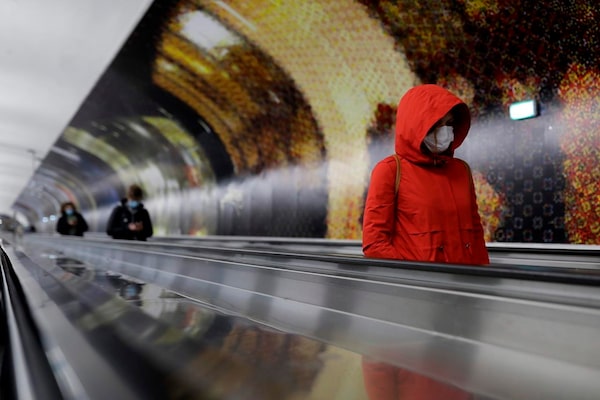
Paris, Oct. 15: Masked commuters make their way through a subway station.Lewis Joly/The Associated Press
“There’s a good argument to be made to hit pause on capital projects” primarily designed to serve commuters going downtown, according to Mr. Walker, the Oregon consultant. But he says city-wide transit will still need funding. “You have the everywhere-to-everywhere, all-the-time demand, especially from people who’ve chosen to live in the city because they don’t want to depend on cars,” he says. “I feel like a permanent loss of peak-of-peak demand is fantastic news for transit, because it means we have a remaining market that is so much easier to serve in terms of cost benefit."
In the end, simple geometry will help transit continue to make its case. A transit vehicle, even with physically distanced passengers, is a far more efficient use of road space than private vehicles or taxis.
Mr. Desmond, in Vancouver, notes that his region is projected to grow by one million people over the next three decades. The area is physically constrained, and there’s little political appetite to keep building highways. “Which gives me a lot of optimism that the big kind of high-capacity transit projects that cities like Vancouver and Toronto and Montreal were all thinking about prior to COVID are still valid,” he says. “Because the laws and dynamics of highway capacity and mobility capacity are not really going to change.”
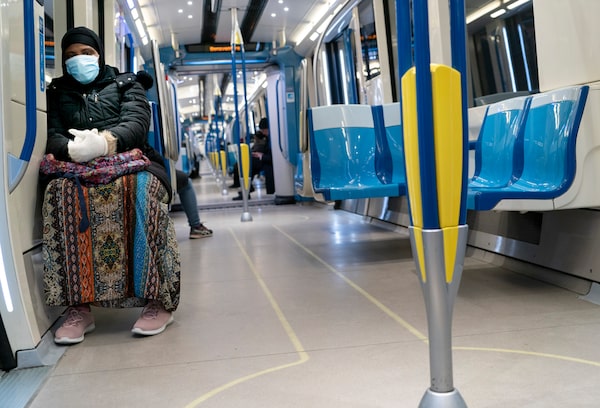
Paul Chiasson/The Canadian Press